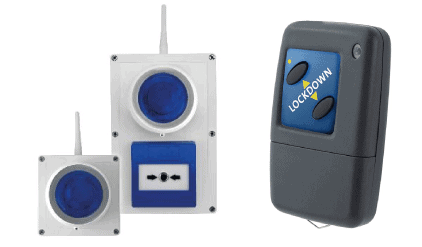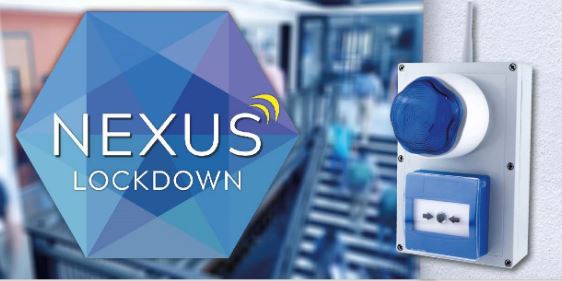CHOOSING A LOCKDOWN SOLUTION:
As part of the Ofsted inspection, schools will be asked if they have a Lockdown Policy – this can be a simple document with guidelines – up until recently they have not had to have an actual Lockdown system installed. However, Ofsted now advocate a dedicated lockdown alarm to be in place, distinctive to the sound of the fire alarm. This is in line with advice from NACTSO (National Counter Terrorism Security Office) which states that the ‘use of fire alarms should be avoided to reduce incorrect response to an incident’.
Whilst Ofsted inspectors are primarily concerned with the performance of the school with regards to learning, they will refer to site security and will want the school to demonstrate that they are at the very least meeting basic criteria to protect pupils, staff and the premises. A poor showing with regards to the safety of pupils in the case of emergency will impact an Ofsted inspection negatively, therefore schools are looking to implement lockdown systems in accordance with their policy, but which one best suits a school’s needs?

WHY WOULD A LOCKDOWN SYSTEM BE USED?
Firstly, what incidents may instigate a lockdown? There can be any number of scenarios leading to a school requiring pupils and staff to make themselves safe within the school premises. Many schools suffer from postcode wars where pupils may be part of gangs and the end of the school day is often a flash point for troubles from nearby schools. An intruder on site with a weapon is an obvious concern for schools or an argument between parents may escalate. How does a school inform pupils and staff in a rapid and safe manner that they are to find a place of safety within the school and stay put?

IP SPEAKERS
An announcement via IP speakers is a good solution but offers no visual alert as well. These speakers also require wiring which takes time and money to install so is very dependent on the school’s budget. The advantage, of course, is that once the system is in the speakers can be used for a whole range of alerts.
USING THE FIRE ALARM
Some schools use fire alerts for lockdown but this can bring about confusion. If the alerts are already being used for break time, adding in a further sound for lockdown can lead to confusion and possibly the incorrect procedure being adopted. Should the fire alarm therefore be considered for lockdown? For smaller sites it is a possibility, particularly if only one sound is currently being used but it is not an ideal solution. Confusion as to whether the alarm means evacuate or stay put is the obvious flaw to using this option.
OTHER VOICE SYSTEMS
So, are live voice-based systems the answer? Again, there are pitfalls. Language of course is a barrier and as most lockdown systems will be prevalent in inner city locations this can be a real problem. A lockdown message with an in-built alert on loop can work in many cases, particularly if the school has regular lockdown drills. However, these tannoy announcements rarely cover outside areas such as playing fields due to cabling so schools with sprawling sites or several outbuildings may not be able to use this option.
ALERTS VIA THE MOBILE PHONE NETWORK
Mobile phone systems are also an option but these come with their own problems. Firstly, the school may have a policy about mobile phone use during learning times. Unless the school looked at providing all staff members with a hand held device purely for lockdown or emergencies, relying on personal phones is pretty much a no-go area. The school has no authority or control over usage and there would be problems surrounding battery usage or signal.
HANDHELD DEVICES
Another option is handheld devices issued to personnel which can be used to alert staff to a variety of problems, not just lockdown events. However, these systems generally rely on colour coding to inform users of the type of event and could be open to misinterpretation. They are also reliant on staff wearing or carrying the devices at all times and keeping them charged.
OUR SOLUTION
The Nexus system is an alternative which offers battery powered units which can be deployed anywhere. They offer an audible AND visual alert to pupils and staff and are distinguishable from fire alerts. The Nexus Lockdown system comprises battery operated units which can be quickly installed on the school site over a weekend or even at the end of the school day, thus minimising disruption to the learning environment. Battery life is around three years. A maximum of 64 units can be installed per site, up to 1km apart. When one NEXUS unit is activated it will trigger all units in range to sound an audible alert or lockdown message, accompanied by a flashing beacon light.
Both internal and external variants are available and decibel levels can be adjusted accordingly. NEXUS units can sound a variety of alerts to differentiate them from a fire alarm – there are 32 sounds to choose from. Alternatively, an annunciator variant can be ordered which has a built-in strobe. There is a standard lockdown message or the school may wish to record their own.

TO CONCLUDE:
Whilst all schools will consider the safety of pupils and staff a top priority, budget restrictions for a lockdown system will be an issue. It is vital that the school carry out a regular fire and security risk assessment of the premises and review it regularly. Staff should be made aware of potential risks and subsequent mitigating measures that are in place and know the differences between a fire alert (meaning evacuation) and a lockdown alert (meaning stay on the premises and make your way to your classroom or nearest place of safety). It is vital that whatever system the school chooses, the operation and policy behind the system is communicated to all members of staff.
If you would like advice or a site visit to view the Nexus range please contact QED on 01772 336111 or email sales@qedgroup.co.uk


